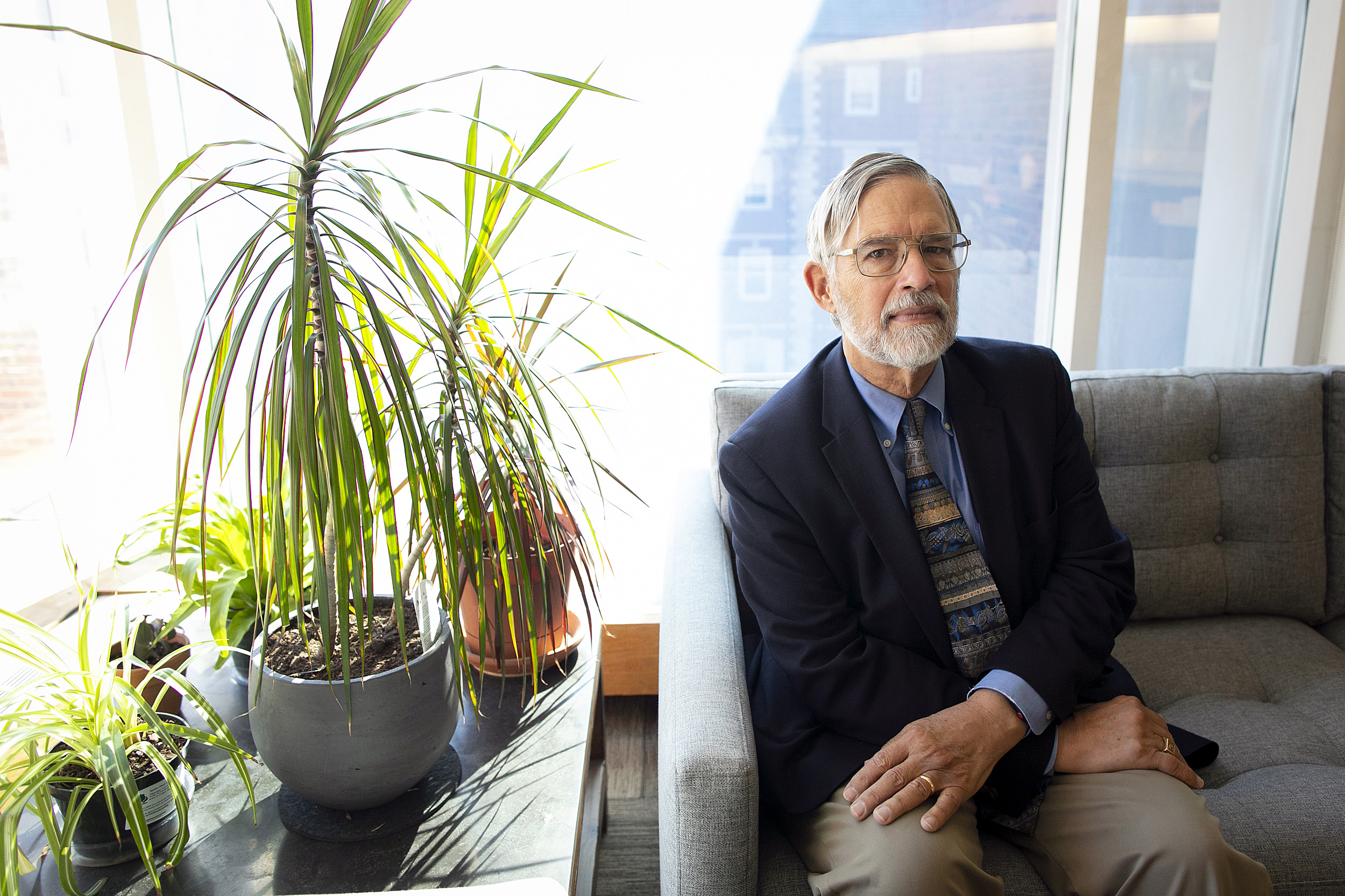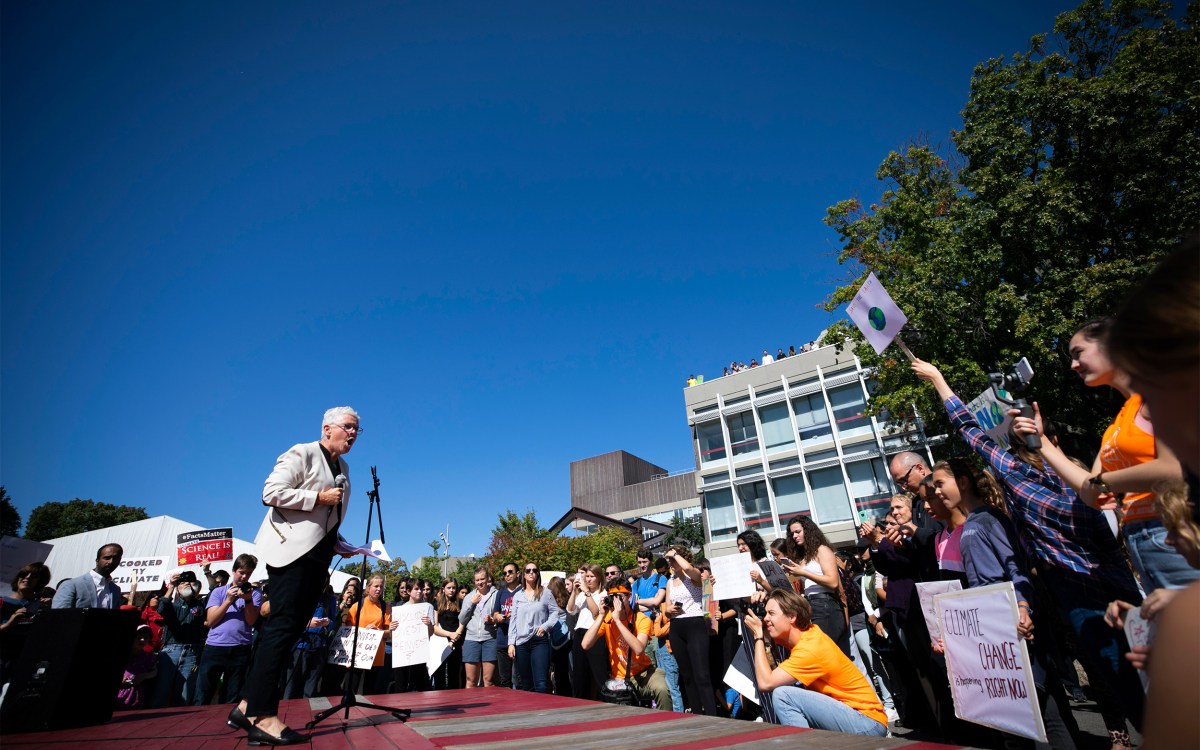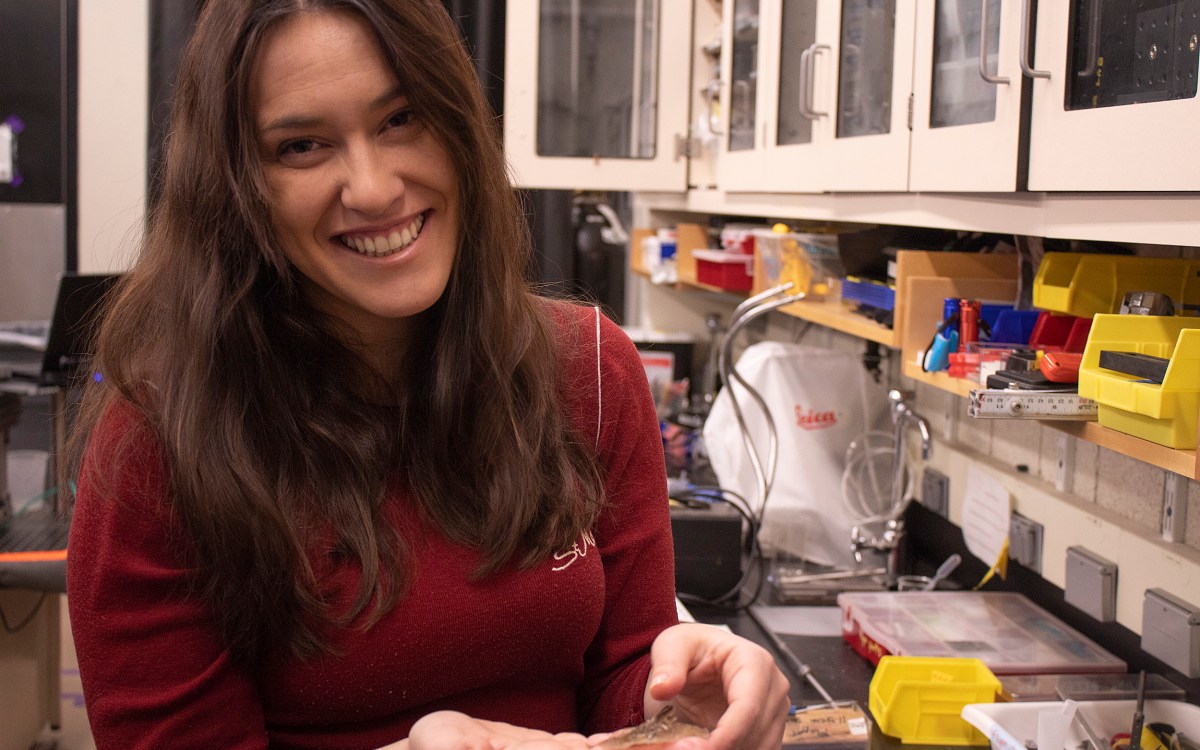
John Holdren, who ran the White House Office of Science and Technology Policy under the Obama administration, comments on the latest IPCC report.
Stephanie Mitchell/Harvard Staff Photographer
Red flags rise on global warming and the seas
Former Obama science adviser says somber intergrovernmental panel report may understate the urgency
The Intergovernmental Panel on Climate Change (IPCC) released a special report last week warning of the mounting effects of global warming on the seas, increasing temperatures and acidification, and on the world’s melting ice. It noted the potential dangers from sea level rise, water shortages in glacier-fed rivers, declining and shifting fish stocks, and increased frequency and severity of storms, among many other hazards. The release came during a week marked by climate-related activities, from youth protests around the world to a United Nations summit meeting of global leaders to consider the issue.
The Gazette spoke with John Holdren, the Teresa and John Heinz Professor of Environmental Policy at the Harvard Kennedy School, of environmental science and policy in the Department of Earth and Planetary Sciences, and affiliated professor in the John A. Paulson School of Engineering and Applied Science. Holdren was director of the White House Office of Science and Technology Policy during the Obama administration and now co-leads the Arctic Initiative at HKS’ Belfer Center for Science and International Affairs.
Surprisingly, while the situation seems urgent, Holdren suggested there may be something positive lurking under the gloom.
Q&A
John Holdren
GAZETTE: These IPCC reports on climate seem to be getting more and more dire. Is there any good news in this latest report, the “Special Report on the Ocean and Cryosphere”?
HOLDREN: I don’t think there’s any good news in the report because it’s focused only on the science, and it’s been true for decades now that virtually all of the new news from climate science has been bad news. The current good news is on the public awareness side. It’s that the fraction of the American public and of publics around the world who understand that climate change is real, caused by humans, already doing significant damage, and that we need to act, has been going up. I actually think we could be close to a political tipping point, because of the combination of expanded grassroots conviction that more needs to be done and these authoritative reports underscoring how pervasive the impacts of climate change already are, even though we’re just at about 1 degree Celsius above the preindustrial temperature.
GAZETTE: It seemed like for many years the job was to convince people about the science of climate change. Are we at a point where that job has been mostly done, positions are more or less baked in on either side, and the question now is going to be decided at the ballot box?
HOLDREN: The polls now show that between 70 and 80 percent of the U.S. electorate is convinced about the realities of climate change. So, the challenge is not to persuade the last 20 or 30 percent. We don’t need them. Seventy or 80 percent support is more than we’ve had for almost any change in our political system over the life of the republic. What we need to do is to persuade those who are already convinced about the science to increase their sense of urgency, to decide that they need to work for and vote for candidates who understand this issue and are prepared to take serious action. Our problem now is that, although a high percentage of the American electorate understands that climate change is real and caused by humans, if you ask the same people, “What keeps you awake at night?” they’re worried about their jobs, getting their kids through college, their retirement, the health system, drugs, terrorism. Climate change tends to come in number eight or nine. But that’s progress. When I started talking to President [Barack] Obama about these matters in 2007, the percentage who believed in the reality of human-caused climate change was between 60 and 65 percent. And the priority ranking was 18 or 19.
GAZETTE: Did the climate protests last week — the fact that they were global in scope and youth-driven — move the needle a little bit?
HOLDREN: Absolutely. In my view, most of the major sociopolitical changes that have occurred in this country and elsewhere — Civil Rights, improving the status of women, and many others — have resulted from a combination of what you might call bottom-up and top-down influences. Consider how the Vietnam War ended. It ended because of the interaction of defections at the top — people like Daniel Ellsberg [who leaked the Pentagon Papers in 1971] on the inside, saying, “Wait a minute, the emperor has no clothes” — and the bottom-up withdrawal of public support that occurred after virtually every American had either a family member or a friend who had been killed or injured in Vietnam, and nobody could really explain why. I think we’re seeing that with climate change: from the top, with reports like those of the IPCC and the U.S. National Climate Assessment, which comes out roughly every four years, on the impacts of climate change on the United States. The last one was released on the day after Thanksgiving last year — Black Friday — and in spite of that it got big coverage in the mainstream media outlets. That in itself was a sign of positive change in concern about this issue.
GAZETTE: Is the “bottom-up” in this case driven by Texas, the Caribbean, the Carolinas getting hit again and again? Is that convincing people?
HOLDREN: I think there’s no question about it. People are experiencing more, longer, stronger heat waves; more and bigger torrential downpours producing more flooding; hotter wildfires burning larger areas and destroying more property; longer allergy seasons; worse pest outbreaks; and more.
If you look at the number of countries in which the highest temperatures ever recorded have occurred in just the last three or four years, it’s absolutely extraordinary. In almost every ocean basin in which hurricanes and typhoons occur, the largest and strongest ones ever recorded have occurred since 2012. One of the things the new IPCC ocean and cryosphere report emphasized very powerfully is that, in many parts of the world, previously once-per-century extreme sea level events are now going to occur every year by 2050. We’re going to have 100-year storms every year. This will happen in spite of a relatively modest change in the globally and annually average surface temperature of the Earth.
GAZETTE: There are a lot of different projections in this report. Was there anything that surprised you?
HOLDREN: The climate scientists who have looked most broadly at the impacts of climate change are not surprised by this report. What you need to understand about the IPCC is that it is the nature of the beast that they only establish the floor on what we know, they are almost never on the cutting edge.
“I don’t think there’s any good news in the report because it’s focused only on the science, and it’s been true for decades now that virtually all of the new news from climate science has been bad news.”
There are scores of authors, and you’re never going to get all those authors to agree on what the top two or three understand in their own field. For example, they said in this new report that, by 2100, sea level might go up by a meter. That’s an increase on what the IPCC said before, but NOAA said in 2012 that the increase could be as much as two meters by 2100. This is typical.
The IPCC approach makes their results very respectable, because they got all these people to agree, but it certainly isn’t describing the worst that could happen. This report says some very sensible things about the influence of rapid climate change in the Arctic. One of these points is that, as the sea ice and the snow cover shrink, we’ll see impacts on the circulation patterns of the atmosphere over much of the Northern Hemisphere. The new report is more cautious than I would be on that particular issue. While the new IPCC report says, “It’s likely that there will be influences in this domain, but our confidence is low to medium,” in my view, I think expert confidence is already high. I think we’re already seeing effects and remaining disagreements among experts in this space are about how exactly it works, about the relative importance of different mechanisms that contribute to making the polar jet weaker and wavier. The waviness means that, in downward lobes, more cold, Arctic air penetrates in the midlatitudes, and, in the upward lobes, more warm midlatitude air penetrates into the far north.
GAZETTE: Is that the polar vortex we’ve seen?
HOLDREN: Yes, it’s what the media have called the polar vortex. Technically, the polar vortex has always been there. What’s changing is its speed and shape. I think the evidence for that [shifting circulation pattern] is stronger than the current IPCC report reflects. If you look at the history of IPCC reports going back to their inception in 1990, each one has reported increasing confidence, higher certainty, and bigger effects. The reality is that many of the effects of climate change are now manifesting more rapidly than was projected even 10 or 15 years ago.
GAZETTE: One thing mentioned during the news conference after the report was released was tipping points where a small change creates a cascade of changes from which there may not be any going back. Are there any of those that you see as particularly worrisome or likely?
HOLDREN: I think the most worrisome one is the possibility that we will get to the point where the thawing permafrost is emitting enormous quantities of both carbon dioxide and methane. We know the permafrost contains 2-and-a-half times as much carbon as is now in the atmosphere. It’s organic carbon that has been frozen undecomposed for millennia. As the permafrost thaws under the rapidly warming Arctic climate, that carbon becomes susceptible to bacterial decomposition. If the circumstances are anaerobic, the decomposition produces methane; if they’re aerobic — if oxygen is present — it produces CO2. Methane is worse in the short term. On a 100-year time scale, the methane is 30 times as potent a heat-trapping gas as CO2 per molecule. We don’t know yet at what point the permafrost will have thawed to a level at which these emissions become a really big deal. There’s already a lot of evidence that the permafrost is disgorging more CO2 and methane than it did before the human-caused warming raised the temperature. But, again, I think the evidence there is a little stronger than the IPCC report reflects.
In second place, but not by much, is the drying out of the tropical forests. If you look at what’s happening already in the Amazon and, to a lesser extent, in the tropics in Indonesia and central Africa, you see very strong drying tendencies already very evident.
GAZETTE: Is that causing the fires we’re seeing in the Amazon?
HOLDREN: Fire has been a longstanding phenomenon in the Amazon, but fires now are bigger, hotter, and get out of control more easily. You see this in Indonesia as well. Roughly a million people in that country are suffering acute air pollution because smoke from the fires is so widespread. We’ve seen that phenomenon in the United States, too. The wildfires in the Northwest — in Northern California, Oregon, and Washington State — have transmitted dangerous levels of fine particulates all the way to New England. These bigger, hotter fires generate a lot of smoke and transmit it farther.
GAZETTE: Climate change is characterized by these big problems and long-term effects. Are there things in the short term that can be reversed?
HOLDREN: The difficulty in a problem like climate change is the time lag. By the time there are dead bodies in the street, you’re already way down the road. At any given time, we’re not experiencing everything that we’re already committed to. That causes policymakers and publics to underestimate how bad it is. If we could somehow freeze the atmospheric concentrations of heat-trapping gases and reflecting particles where they are today, the temperature would still rise to close to 1.5 degrees C above preindustrial times. If we actually want to stay below 1.5 — and the IPCC report from last fall argued that doing so would bring big benefits compared to going to 2 degrees or more — we really have to start reducing our emissions very rapidly. We’ll eventually have to be actually pulling more carbon dioxide out of the atmosphere than we’re adding in order to meet that extremely challenging goal.
The good news is it’s still up to us how bad the impacts of climate change get. It’s going to get worse, but it’ll get a lot less bad if we take action than if we don’t. If we do a lot, we can end up with a temperature increase of 2 or 2.5 degrees. If there are major breakthroughs, maybe we can get back to 1.5. And that will be a vastly better world than business as usual, where, by the turn of this century, you get to 4 or 4.5 degrees C.








